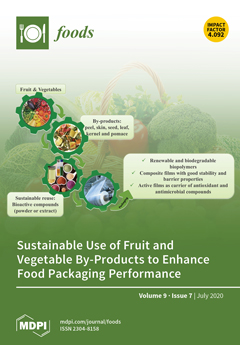The potential of collagens to release biopeptides was evaluated using the BIOPEP-UWM-implemented quantitative criteria including the frequency of the release of fragments with a given activity by selected enzyme(s) (A
E), relative frequency of release of fragments with a given activity by
[...] Read more.
The potential of collagens to release biopeptides was evaluated using the BIOPEP-UWM-implemented quantitative criteria including the frequency of the release of fragments with a given activity by selected enzyme(s) (A
E), relative frequency of release of fragments with a given activity by selected enzyme(s) (W), and the theoretical degree of hydrolysis (DH
t). Cow, pig, sheep, chicken, duck, horse, salmon, rainbow trout, goat, rabbit, and turkey collagens were theoretically hydrolyzed using: stem bromelain, ficin, papain, pepsin, trypsin, chymotrypsin, pepsin+trypsin, and pepsin+trypsin+chymotrypsin. Peptides released from the collagens having comparable A
E and W were estimated for their likelihood to be bioactive using PeptideRanker Score. The collagens tested were the best sources of angiotensin I-converting enzyme (ACE) and dipeptidyl peptidase IV (DPP-IV) inhibitors. A
E and W values revealed that pepsin and/or trypsin were effective producers of such peptides from the majority of the collagens examined. Then, the SwissTargetPrediction program was used to estimate the possible interactions of such peptides with enzymes and proteins, whereas ADMETlab was applied to evaluate their safety and drug-likeness properties. Target prediction revealed that the collagen-derived peptides might interact with several human proteins, especially proteinases, but with relatively low probability. In turn, their bioactivity may be limited by their short half-life in the body.
Full article






